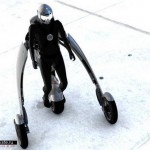Archive for 2009
Review of control strategies for robotic movement training after neurologic injury
- Тип контента: Научная статья
- Номер документа: 6334
- Название документа: Review of control strategies for robotic movement training after neurologic injury
- Номер (DOI, IBSN, Патент): 10.1186/1743-0003-6-20
- Изобретатель/автор: Laura Marchal-Crespo, David J Reinkensmeyer
- Правопреемник/учебное заведение: University of California, Irvine
- Дата публикации документа: 2009-06-16
- Страна опубликовавшая документ: США
- Язык документа: Английский
- Наименование изделия: Не заполнено
- Источник: Journal of NeuroEngineering and Rehabilitation
- Вложения: Да
- Аналитик: Глаголева Елена
 There is increasing interest in using robotic devices to assist in movement training following neurologic injuries such as stroke and spinal cord injury. This paper reviews control strategies for robotic therapy devices. Several categories of strategies have been proposed, including, assistive, challenge-based, haptic simulation, and coaching. The greatest amount of work has been done on
There is increasing interest in using robotic devices to assist in movement training following neurologic injuries such as stroke and spinal cord injury. This paper reviews control strategies for robotic therapy devices. Several categories of strategies have been proposed, including, assistive, challenge-based, haptic simulation, and coaching. The greatest amount of work has been done on
developing assistive strategies, and thus the majority of this review summarizes techniques for implementing assistive strategies, including impedance-, counterbalance-, and EMG- based controllers, as well as adaptive controllers that modify control parameters based on ongoing participant performance. Clinical evidence regarding the relative effectiveness of different types of robotic the-rapy controllers is limited, but there is initial evidence that some control strategies are more effective than others. It is also now apparent there may be mechanisms by which some robotic control approaches might actually decrease the recovery possible with comparable, nonrobotic forms of training. In future research, there is a need for head-to-head comparison of control algorithms in randomized, controlled clinical trials, and for improved models of human motor recovery to provide a more rational framework for designing robotic therapy control strategies.
Категория: Научные статьи | Нет комментариев »
A pneumatic power harvesting ankle-foot orthosis to prevent foot-drop
- Тип контента: Научная статья
- Номер документа: 6331
- Название документа: A pneumatic power harvesting ankle-foot orthosis to prevent foot-drop
- Номер (DOI, IBSN, Патент): 10.1186/1743-0003-6-19
- Изобретатель/автор: Serena N Tyson, Scott D Manwaring, Robin Chin, K Alex Shorter, Joel N Gilmer, Géza Kogler, Eric Loth, Elizabeth T Hsiao-Wecksler
- Правопреемник/учебное заведение: University of Illinois at Urbana-Champaign, Georgia Institute of Technology
- Дата публикации документа: 2009-06-16
- Страна опубликовавшая документ: США
- Язык документа: Английский
- Наименование изделия: Не заполнено
- Источник: Journal of NeuroEngineering and Rehabilitation
- Вложения: Да
- Аналитик: Глаголева Елена
 Background: A self-contained, self-controlled, pneumatic power harvesting ankle-foot orthosis (PhAFO) to manage foot-drop was developed and tested. Foot-drop is due to a disruption of the motor control pathway and may occur in numerous pathologies such as stroke, spinal cord injury, multiple sclerosis, and cerebral palsy. The objectives for the prototype PhAFO are to provide toe clearance during swing, permit free ankle motion during stance, and harvest the needed power with an underfoot bellow pump pres-surized during the stance phase of walking. Methods: The PhAFO was constructed from a two-part (tibia and foot) carbon composite structure with an articulating ankle joint. Ankle motion control was accomplished through a camfollower locking mechanism actuated via a pneumatic circuit connected to the bellow pump and embedded in the foam sole. Biomechanical performance of the prototype or-thosis was assessed during multiple trials of treadmill walking of an able-bodied control subject (n = 1). Motion capture and pres-sure measurements were used to investigate the effect of the PhAFO on lower limb joint behavior and the capacity of the bellow pump to repeatedly generate the required pneumatic pressure for toe clearance. Results: Toe clearance during swing was successfully achieved during all trials; average clearance 44 ± 5 mm. Free ankle motion was observed during stance and plantarflexion was blocked during swing. In addition, the bellow component repeatedly generated an average of 169 kPa per step of pressure during ten minutes of walking. Conclusion: This study demonstrated that fluid power could be harvested with a pneumatic circuit built into an AFO, and used to operate an actuated cam-lock mechanism that controls anklefoot motion at specific periods of the gait cycle.
Background: A self-contained, self-controlled, pneumatic power harvesting ankle-foot orthosis (PhAFO) to manage foot-drop was developed and tested. Foot-drop is due to a disruption of the motor control pathway and may occur in numerous pathologies such as stroke, spinal cord injury, multiple sclerosis, and cerebral palsy. The objectives for the prototype PhAFO are to provide toe clearance during swing, permit free ankle motion during stance, and harvest the needed power with an underfoot bellow pump pres-surized during the stance phase of walking. Methods: The PhAFO was constructed from a two-part (tibia and foot) carbon composite structure with an articulating ankle joint. Ankle motion control was accomplished through a camfollower locking mechanism actuated via a pneumatic circuit connected to the bellow pump and embedded in the foam sole. Biomechanical performance of the prototype or-thosis was assessed during multiple trials of treadmill walking of an able-bodied control subject (n = 1). Motion capture and pres-sure measurements were used to investigate the effect of the PhAFO on lower limb joint behavior and the capacity of the bellow pump to repeatedly generate the required pneumatic pressure for toe clearance. Results: Toe clearance during swing was successfully achieved during all trials; average clearance 44 ± 5 mm. Free ankle motion was observed during stance and plantarflexion was blocked during swing. In addition, the bellow component repeatedly generated an average of 169 kPa per step of pressure during ten minutes of walking. Conclusion: This study demonstrated that fluid power could be harvested with a pneumatic circuit built into an AFO, and used to operate an actuated cam-lock mechanism that controls anklefoot motion at specific periods of the gait cycle.
Категория: Научные статьи | Нет комментариев »
Pilot study of Lokomat versus manual-assisted treadmill training for locomotor recovery post-stroke
- Тип контента: Научная статья
- Номер документа: 6328
- Название документа: Pilot study of Lokomat versus manual-assisted treadmill training for locomotor recovery post-stroke
- Номер (DOI, IBSN, Патент): 10.1186/1743-0003-6-18
- Изобретатель/автор: Kelly P Westlake, Carolynn Patten
- Правопреемник/учебное заведение: University of California, San Francisco, University of Florida, Gainesville
- Дата публикации документа: 2009-06-12
- Страна опубликовавшая документ: США
- Язык документа: Английский
- Наименование изделия: Не заполнено
- Источник: Journal of NeuroEngineering and Rehabilitation
- Вложения: Да
- Аналитик: Глаголева Елена
 Background: While manually-assisted body-weight supported treadmill training (BWSTT) has revealed improved locomotor function in persons with post-stroke hemiparesis, outcomes are inconsistent and it is very labor intensive. Thus an alternate treatment app-roach is desirable. Objectives of this pilot study were to: 1) compare the efficacy of body-weight supported treadmill training (BWSTT) combined with the Lokomat robotic gait orthosis versus manually-assisted BWSTT for locomotor training post-stroke, and 2) assess effects of fast versus slow treadmill training speed. Methods: Sixteen volunteers with chronic hemiparetic gait (0.62 ± 0.30 m/s) post-stroke were randomly allocated to Lokomat (n = 8) or manual-BWSTT (n = 8) 3×/wk for 4 weeks. Groups were also stratified by fast (mean 0.92 ± 0.15 m/s) or slow (0.58 ± 0.12 m/s) training speeds. The primary outcomes were self-selected overground wal-king speed and paretic step length ratio. Secondary outcomes included: fast overground walking speed, 6-minute walk test, and a battery of clinical measures. Results: No significant differences in primary outcomes were revealed between Lokomat and manual groups as a result of training. However, within the Lokomat group, self-selected walk speed, paretic step length ratio, and four of the six secondary measures improved (p = 0.04–0.05, effect sizes = 0.19–0.60). Within the manual group, only balance scores improved (p = 0.02, effect size = 0.57). Group differences between fast and slow training groups were not revealed (p ≥ 0.28). Conclusion: Results suggest that Lokomat training may have advantages over manual-BWSTT following a modest intervention dose in chronic hemiparetic persons and further, that our training speeds produce similar gait improvements. Suggestions for a larger randomized controlled trial with optimal study parameters are provided.
Background: While manually-assisted body-weight supported treadmill training (BWSTT) has revealed improved locomotor function in persons with post-stroke hemiparesis, outcomes are inconsistent and it is very labor intensive. Thus an alternate treatment app-roach is desirable. Objectives of this pilot study were to: 1) compare the efficacy of body-weight supported treadmill training (BWSTT) combined with the Lokomat robotic gait orthosis versus manually-assisted BWSTT for locomotor training post-stroke, and 2) assess effects of fast versus slow treadmill training speed. Methods: Sixteen volunteers with chronic hemiparetic gait (0.62 ± 0.30 m/s) post-stroke were randomly allocated to Lokomat (n = 8) or manual-BWSTT (n = 8) 3×/wk for 4 weeks. Groups were also stratified by fast (mean 0.92 ± 0.15 m/s) or slow (0.58 ± 0.12 m/s) training speeds. The primary outcomes were self-selected overground wal-king speed and paretic step length ratio. Secondary outcomes included: fast overground walking speed, 6-minute walk test, and a battery of clinical measures. Results: No significant differences in primary outcomes were revealed between Lokomat and manual groups as a result of training. However, within the Lokomat group, self-selected walk speed, paretic step length ratio, and four of the six secondary measures improved (p = 0.04–0.05, effect sizes = 0.19–0.60). Within the manual group, only balance scores improved (p = 0.02, effect size = 0.57). Group differences between fast and slow training groups were not revealed (p ≥ 0.28). Conclusion: Results suggest that Lokomat training may have advantages over manual-BWSTT following a modest intervention dose in chronic hemiparetic persons and further, that our training speeds produce similar gait improvements. Suggestions for a larger randomized controlled trial with optimal study parameters are provided.
Категория: Научные статьи | Нет комментариев »
The exoskeletons are here
- Тип контента: Научная статья
- Номер документа: 6324
- Название документа: The exoskeletons are here
- Номер (DOI, IBSN, Патент): 10.1186/1743-0003-6-17
- Изобретатель/автор: Daniel P Ferris
- Правопреемник/учебное заведение: University of Michigan
- Дата публикации документа: 2009-06-09
- Страна опубликовавшая документ: США
- Язык документа: Английский
- Наименование изделия: Не заполнено
- Источник: Journal of NeuroEngineering and Rehabilitation
- Вложения: Да
- Аналитик: Глаголева Елена
 It is a fantastic time for the field of robo-tic exoskeletons. Recent advances in actuators, sensors, materials, batteries, and compu-ter processors have given new hope to crea-ting the exoskeletons of yesteryear’s science fiction. While the most common goal of an exoskeleton is to provide superhuman strength or endurance, scientists and engineers around the world are building exoskeletons with a wide range of diverse purposes. Exoskeletons can help patients with neurological disabilities improve their motor perfor-mance by providing task specific practice. Exoskeletons can help physiologists better understand how the human body works by pro-viding a novel experimental perturbation. Exoskeletons can even help power mobile phones, music players, and other portable elec-tronic devices by siphoning mechanical work performed during human locomotion. This special thematic series on robotic lower limb exoskeletons and orthoses includes eight pa-pers presenting novel contributions to the field. The collective message of the papers is that robotic exoskeletons will contribute in many ways to the future benefit of humankind, and that future is not that distant.
It is a fantastic time for the field of robo-tic exoskeletons. Recent advances in actuators, sensors, materials, batteries, and compu-ter processors have given new hope to crea-ting the exoskeletons of yesteryear’s science fiction. While the most common goal of an exoskeleton is to provide superhuman strength or endurance, scientists and engineers around the world are building exoskeletons with a wide range of diverse purposes. Exoskeletons can help patients with neurological disabilities improve their motor perfor-mance by providing task specific practice. Exoskeletons can help physiologists better understand how the human body works by pro-viding a novel experimental perturbation. Exoskeletons can even help power mobile phones, music players, and other portable elec-tronic devices by siphoning mechanical work performed during human locomotion. This special thematic series on robotic lower limb exoskeletons and orthoses includes eight pa-pers presenting novel contributions to the field. The collective message of the papers is that robotic exoskeletons will contribute in many ways to the future benefit of humankind, and that future is not that distant.
Категория: Научные статьи | 2 комментария »
Экзоскелет на колесах. Дизайн мотоцикла будущего.
- Тип контента: Новостная статья
- Номер документа: 4512
- Название документа: Экзоскелет на колесах. Дизайн мотоцикла будущего.
- Номер (DOI, IBSN, Патент): Не заполнено
- Изобретатель/автор: Не заполнено
- Правопреемник/учебное заведение: Не заполнено
- Дата публикации документа: 2009-06-05
- Страна опубликовавшая документ: Россия
- Язык документа: Русский
- Наименование изделия: Не заполнено
- Источник: http://www.novate.ru/blogs/050609/12191/
- Вложения: Не заполнено
- Аналитик: Helix
 Студент из Пасадены Джейк Лоняк предлагает концепт футуристического мотоцикла, представляющего собой экзоскелет на трех колесах. Причем, не просто экзоскелет, а с возможностью трансформации из одного состояния – прогулочного, в другое – скоростное.
Студент из Пасадены Джейк Лоняк предлагает концепт футуристического мотоцикла, представляющего собой экзоскелет на трех колесах. Причем, не просто экзоскелет, а с возможностью трансформации из одного состояния – прогулочного, в другое – скоростное.
Категория: Wearable Motorcycle | 2 комментария »
Статистика
Категорий: 179
Статей всего: 2,003
По типу:
Видео: 36
Выдержка с форума: 1
Контактные данные: 12
Научная статья: 1388
Не заполнено: 5
Новостная статья: 317
Обзор технологии: 42
Патент: 219
Тех.подробности: 34
Тип: 1
Комментариев: 8,697
Изображений: 3,005
Подробней...
ТОР 10 аналитиков
-
Глаголева Елена - 591
Дмитрий Соловьев - 459
Helix - 218
Ридна Украина))) - 85
Наталья Черкасова - 81
max-orduan - 29
Елена Токай - 15
Роман Михайлов - 9
Мансур Жигануров - 4
Дуванова Татьяна - 3
Календарь
| Пн | Вт | Ср | Чт | Пт | Сб | Вс |
|---|---|---|---|---|---|---|
| « Ноя | ||||||
| 1 | 2 | 3 | 4 | 5 | ||
| 6 | 7 | 8 | 9 | 10 | 11 | 12 |
| 13 | 14 | 15 | 16 | 17 | 18 | 19 |
| 20 | 21 | 22 | 23 | 24 | 25 | 26 |
| 27 | 28 | 29 | 30 | 31 | ||
Авторизация
Ошибка в тексте?
Выдели её мышкой!
И нажми Ctrl+Enter